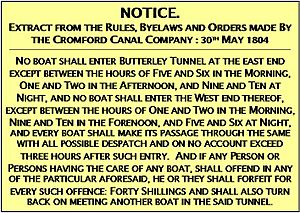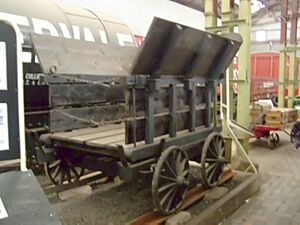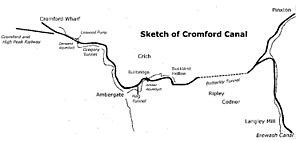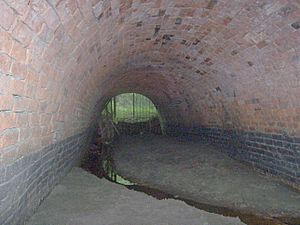Butterley Tunnel facts for kids
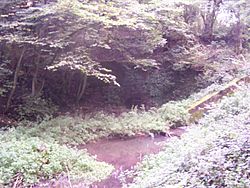 |
|
| The Eastern Portal of Butterley Tunnel in 2006 | |
| Overview | |
|---|---|
| Location | Peak District, Derbyshire |
| Status | Closed |
| Waterway | Cromford Canal |
| Operation | |
| Rebuilt | 1900 |
| Owner | Cromford Canal Company / Midland Railway Company |
| Technical | |
| Length | 3,083 yards (2,819 m) |
| Tunnel clearance | 8 ft (2.4 m) |
| Towpath | No |
The Butterley Tunnel is a very long, old canal tunnel in Derbyshire, England. It's about 3,083 yards (2,819 meters) long. It was built for the Cromford Canal and opened in 1794. This tunnel is no longer used today. In 2013, parts of the tunnel and its special underground loading area were made a scheduled monument. This means they are important historical sites that are protected.
Contents
Building the Butterley Tunnel
When it was built, the Butterley Tunnel was one of the longest canal tunnels in the world. It was about 9 feet (2.7 meters) wide and 8 feet (2.4 meters) high above the water.
To build the tunnel, workers dug 33 shafts down from the surface. They used a steam engine to pump out water from the digging areas. The canal needed water, which came from the 50-acre (20-hectare) Butterley Reservoir. This reservoir is on a hill above the tunnel. Water flowed from the reservoir into the tunnel through a special channel called an adit. This adit joined the tunnel about 600 yards (549 meters) from its western end.
The tunnel and reservoirs were built by the Butterley Company. This company was started in 1790 by Benjamin Outram and Francis Beresford. Later, William Jessop and John Wright joined them.
How Boats Moved Through the Tunnel
The Butterley Tunnel did not have a towpath. A towpath is a path next to a canal where horses would walk to pull boats. Since there was no towpath, boats had to be moved through the tunnel by hand. This was done by a process called legging. Crew members would lie on their backs on the boat and push their feet against the tunnel walls or roof. This would slowly move the boat forward.
Signs were placed at both ends of the tunnel. These signs told boat crews when they could enter the tunnel. This was important because the tunnel was narrow, and boats could only go in one direction at a time. People who didn't follow these rules could be fined.
The Underground Wharf
About 880 yards (805 meters) from the tunnel's western end, there is a special underground wharf. A wharf is a place where boats can load or unload goods. This part of the tunnel is wider, about 16 feet (4.9 meters) across, and about 60 yards (55 meters) long.
One of the tunnels leading from this underground wharf went to the Butterley Company's Butterley Carr Pit. This pit opened in 1812 and allowed coal to be loaded directly onto boats at the underground wharf.
There were also vertical shafts (like deep holes) from the wharf. These shafts allowed special boxes of goods to be lowered from the Butterley Company's works (which were on the hill above) directly onto boats in the tunnel. These boxes were used on the Little Eaton Tramway, a type of early railway. At first, a large water bucket was used to help lower and raise the boxes. Later, a steam engine was used for this job. This underground wharf was very unusual and rare in the United Kingdom.
In the 1980s, old buildings from the Butterley Company were taken down. This revealed the original blast furnace from 1790. In front of the furnace, there are vertical shafts that lead down to a short tunnel connected to the canal tunnel near the wharf.
Why the Tunnel Closed
In 1889, the tunnel had to close for four years because the ground above it sank. This is called subsidence. When the tunnel reopened in 1893, some canal customers had already started using railway companies instead.
In 1900, part of the tunnel collapsed again, also due to mining subsidence. This split the Cromford Canal into two parts. The tunnel has never been fully repaired since then. Experts looked at the tunnel in 1904 and 1907, but they decided it was too expensive to fix. Commercial boats stopped using the canal completely in 1944.
After the Closure
"The Friends of Cromford Canal" is a group of volunteers who want to restore the entire Cromford Canal and the Butterley Tunnel. They sometimes offer horse-drawn boat rides on a small part of the canal that is still usable near the village of Cromford.
The Butterley Tunnel has been made longer twice since it was first built. The Midland Railway built a railway line over the western end of the tunnel. A new section of tunnel was added underneath the railway, making the tunnel longer. Later, the A38 road was built over the old railway track. This required another small section to be added to the western end, making the tunnel about 3,083 yards (2,819 meters) long in total.
The Golden Valley Light Railway (GVLR) runs very close to the tunnel's eastern end. This is a narrow gauge railway that tourists can ride. It's part of the Midland Railway – Butterley. Near the eastern end of the tunnel is the Newlands Inn. This inn was a place where canal boat horses were changed, and where boat crews could rest before or after legging their boats through the tunnel.
Images for kids



